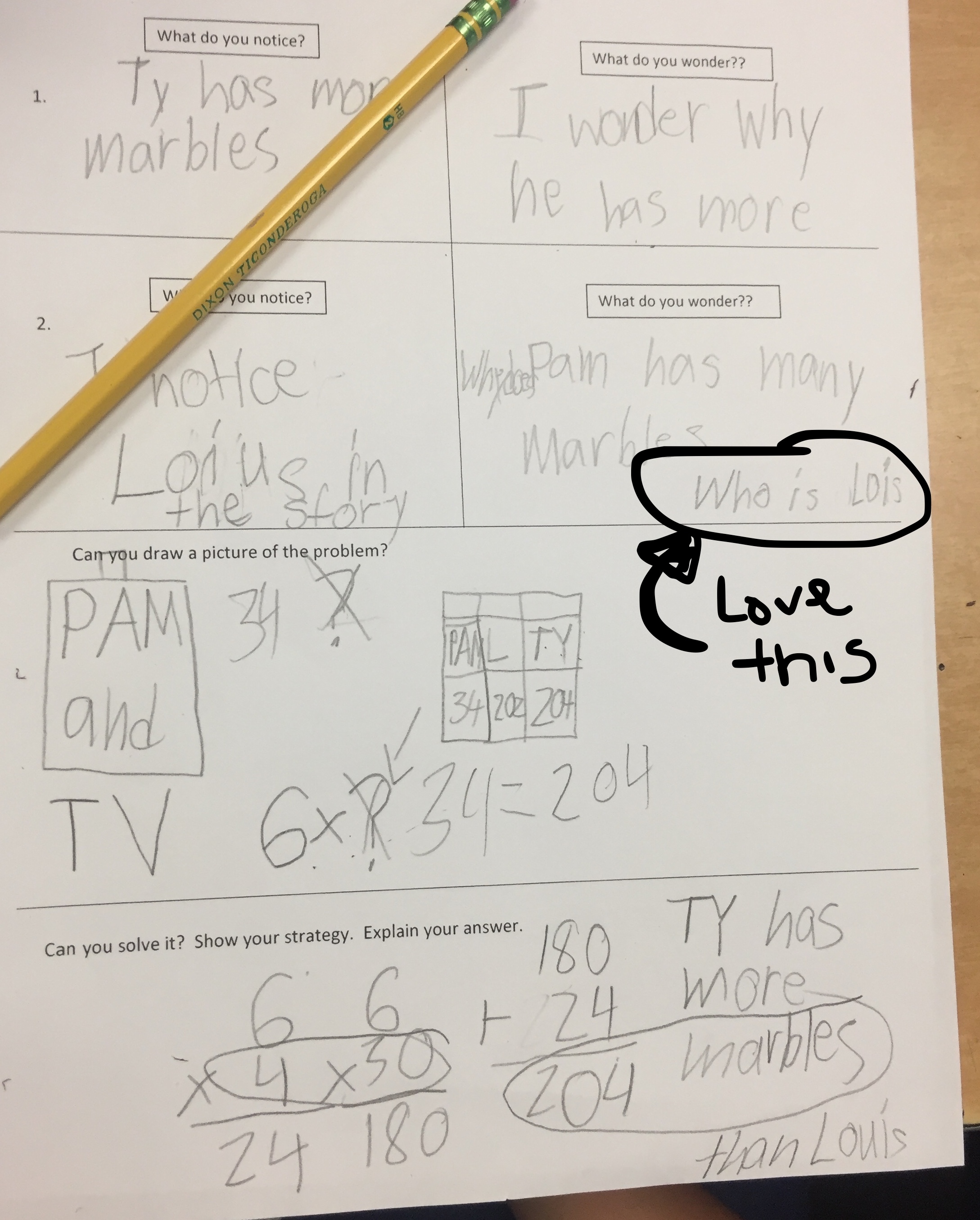Back in January (yes, I’m back logged a few months) I did a professional development for 4 – 6th grade teachers. I was asked about presenting something that could help with the ever-looming testing in the spring. My purpose was to introduce them to the strategy of Notice & Wonder while showing them what a numberless word problem was. I emphasized the fact that we have to slow down the problem solving. The students need to focus on content rather than just grab numbers and add them together (I call them calculator kids). Both strategies (and my presentation) were a HUGE success. Each teacher not only left with a base knowledge of notice and wonder, they also left with 2-3 numberless word problems to try in their classrooms. One 5th grade team tried them out the very next day.

Teachers got to write their own numberless word problems.
Fast forward a few weeks, when I met with my 4th grade teacher, Mrs. P. We planned a lesson which would introduce the kiddos to a numberless word problem. During our planning session, we came up with the idea of putting a bunch of problems together so that the students could review all the previous material. Little did I know, this one planning session turned into me running between 3 different schools showing all 3rd and 4th grade students numberless word problems.
Now let’s begin with my favorite —the marble problem. I did separate marble problems for both 3rd and 4th grades. And both problems created the most conversation.
I got the students into a routine by starting off with “notice & wonder” before drawing any concepts or figuring any of the problem out. I created this template to help the students navigate through the problem. It also helped that they kept track of their thoughts throughout the process.
3rd grade (each number was a separate slide of a powerpoint)
- Jeanne has marbles.
- Jeanne has marbles. Some marbles are blue and some marbles are yellow.
- Jeanne has marbles. Some marbles are blue and some marbles are yellow. The rest of the marbles are green.
- Jeanne has 12 marbles. Some of the marbles are blue and some marbles are yellow. The rest of the marbles are green.
- Jeanne has 12 marbles. 3/12 of the marbles are blue and 2/12 of the marbles are yellow. The rest of the marbles are green. How many marbles are green?
Was a little apprehensive about doing a problem on fractions with 3rd grade, but they stepped up to the plate and were superb with their problem solving.
4th grade – each slide was a separate slide of a powerpoint.
- Ty has more marbles than his sister, Pam.
2. Ty has more marbles than his sister, Pam. Pam has many marbles.
3. Ty has more marbles than his sister, Pam. Pam has many marbles. Louis has marbles.
4. Ty has 6 times as many marbles than his sister, Pam. Pam has many marbles. Louis has marbles.
5. Ty has 6 times as many marbles than his sister, Pam. Pam has 34 marbles. Louis has 202 marbles. Who has more marbles, Ty or Louis?
By the time we got to number 3 (…..Louis has marbles.) the students were freaking out. “Who’s Louis?” “Why does he need marbles?”
By the time they got to the last layer of information, they were excited to find the answer. More importantly, they knew what they needed to do.

Final thoughts….
- “Layering” the information of a word problem really helps the students focus on the content of the problem.
- It slows down the problem solving process.
- Students get to create a mini – movie in their heads before they are slapped with numbers and the question.
- The teachers noticed that by the time students got the question, they knew how to solve. They were also able to draw out and model their thinking.
- One big AH-HA was that students don’t know how to properly give an answer. They need to work on being specific with their thoughts. For instance, students would tell me 7. I asked them 7 what—7 flamingos at a dance? 7 cows jumping over the moon? Students need to be able to write/type out their full complete answers to get credit on the tests.
- The notice/wonder routine is really inclusive. Teachers were amazed at how many students were engaged and participating. Everyone of the students had something to say.
- Lastly—Mrs. P did a notice and wonder talk with her students about the whole numberless word problem. This is what they had to share….

Such a worthwhile routine especially before testing where there are MANY word problems. Here’s hoping that all of it transferred to the test.
Crossing my fingers…
Kristen


Comments
Pingback: The Slow Reveal | Teaching to the Beat of a Different Drummer
Hi, Kristin. I love the idea of asking them to #NoticeWonder about numberless word problems – what a neat reflection! And this whole thing sounds really awesome. I’m glad that teachers are having such a positive experience trying these ideas out. How exciting it must be for you when they like your PD – I love that feeling.
Hi Annie, Thank you so much. First of all, teachers are loving #NoticeWonder. I have one principal who uses it at every staff meeting to look at data. Secondly, it just seemed like a natural “marriage”—to incorporate N/W with numberless word problems. From the PD, you think I was giving away pure gold. Teachers loved it! And it was easy for them to put together themselves. Yes–it was a good thing.
Pingback: Where did the numbers go?